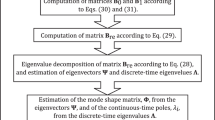Abstract
This study aims at incorporating a certain degree of formalization to stabilization diagrams by integrating two additional features: the former introduces a new quantity, the modal dispersion metric, which expresses a certain part of the total stochastic vibration energy, and it is attributed to each vibration mode. The latter implements a polynomial chaos expansion framework for quantifying the effect of the operational conditions into the modal dispersion index. By combining these two features, a vibration mode is deemed as a structural one when it appears stabilized, i.e., comes with a high modal dispersion index and is operationally normalized. The proposed method is characterized by global applicability, thus also serving as a common measure of effectiveness among diverse parametric identification methods.
Access this chapter
Tax calculation will be finalised at checkout
Purchases are for personal use only
Similar content being viewed by others
Abbreviations
- DA:
-
Dispersion analysis
- DOF:
-
Degrees–of–freedom
- ERA:
-
Eigensystem realization algorithm
- N/S:
-
Noisetosignal
- LHS:
-
Latin hypercube sampling
- LTI:
-
Linear time–invariant
- MDM:
-
Modal dispersion metric
- nMDM:
-
Normalized modal dispersion metric
- PCE:
-
Polynomial chaos expansion
- PDF:
-
Probability density function
- SD(s):
-
Stabilization diagram(s)
References
Reynders E (2012) System Identification methods for (Operational) modal analysis: review and comparison. Arch Comput Meth Eng. 19(1):51–124
Antonacci E, De Stefano A, Gattulli V, Lepidi M, Matta E (2012) Comparative study of vibration-based parametric identification techniques for a three-dimensional frame structure. Struct Control Health Monit 19(5):579–608
Bayraktar A, Altunişik AC, Sevim B, Türker T (2011) Seismic response of a historical masonry minaret using a finite element model updated with operational modal testing. J Vib Control 17(1):129–149
Lau J, Lanslots J, Peeters B, Van der Auweraer H (2007) Automatic modal analysis: reality or myth? In: Proceedings of the 25th international modal analysis conference, IMAC-XXV, Orlando
Giraldo D, Caicedo JM, Song W, Mogan B, Dyke SJ (2009) Modal identification through ambient vibration: A comparative study. In: Proceedings of the 24th International modal analysis conference, IMAC-XXIV, St Louis
Van Der Auweraer H, Peeters B (2004) Discriminating physical poles from mathematical poles in high order systems: Use and automation of the stabilization diagram. In: Proceedings of the 21st IEEE instrumentation and measurement technology conference, Como
Juang JN, Pappa RS (1985) An eigensystem realization algorithm for modal parameter identification and model reduction. JGuid Control Dyn 8(5):620–627
Florakis A, Fassois SD, Hemez FM (2001) MIMO LMS-ARMAX identification of vibrating structures-Part II: A critical assessment. Mech Syst Sig Process 15(4):737–758
Fassois SD (2001) MIMO LMS-ARMAX identification of vibrating structures-Part I: The method. Mech Syst Sig Process 15(4):723–735
Reynders E, De Roeck G (2008) Reference-based combined deterministic-stochastic subspace identification for experimental and operational modal analysis. Mech Syst Sig Process 22(3):617–637
Goethals I, De Moor B (2002) Model reduction and energy analysis as a tool to detect spurious modes. In: Proceedings of the 2002 International conference on noise and vibration engineering, ISMA, Leuven, Belgium
Dertimanis VK (2013) On the use of dispersion analysis for model assessment in structural identification. J Vib Control 19(15):2270–2284
Dertimanis VK Koulocheris DV (2011) VAR based state-space structures: realization, statistics and spectral analysis. Lecture Notes in Electrical Engineering, vol 85. Springer, New york, pp 301–315
Kullaa J (2011) Vibration-based structural health monitoring under variable environmental or operational conditions. CISM courses and lectures, chapter 4, vol. 520. Springer, New York, pp 107–181
Peeters B, Roeck GD (2001) One-year monitoring of the z24-bridge: environmental effects versus damage events. Earthq Eng Struct Dyn 30(2):149–171
Dertimanis VK, Chatzi EN (2014) Dispersion–corrected stabilization diagrams for model order assessment in structural identification. In: 7th European workshop on structural health monitoring 2012, EWSHM 2012, Nantes
Verhaegen M (1994) Identification of the deterministic part of MIMO state space models given in innovations form from input-output data. Automatica 30(1):61–74
Fadali MS (2009) Digital control engineering: analysis and design. Academic Press, Massachusetts
Meyer CD (2000) Matrix analysis and applied linear algebra. Society for industrial and applied mathematics, Philadelphia, USA
Blatman G, Sudret B (2010) An adaptive algorithm to build up sparse polynomial chaos expansions for stochastic finite element analysis. Prob Eng Mech 25(2):183–197
**u D, Karniadakis G (2002) The wiener-askey polynomial chaos for stochastic differential equations. SIAM J Sci Comput 24(2):619–644
Author information
Authors and Affiliations
Corresponding author
Editor information
Editors and Affiliations
Rights and permissions
Copyright information
© 2015 The Society for Experimental Mechanics, Inc.
About this paper
Cite this paper
Dertimanis, V.K., Spiridonakos, M.D., Chatzi, E.N. (2015). Dispersion–Corrected, Operationally Normalized Stabilization Diagrams for Robust Structural Identification. In: Atamturktur, H., Moaveni, B., Papadimitriou, C., Schoenherr, T. (eds) Model Validation and Uncertainty Quantification, Volume 3. Conference Proceedings of the Society for Experimental Mechanics Series. Springer, Cham. https://doi.org/10.1007/978-3-319-15224-0_8
Download citation
DOI: https://doi.org/10.1007/978-3-319-15224-0_8
Publisher Name: Springer, Cham
Print ISBN: 978-3-319-15223-3
Online ISBN: 978-3-319-15224-0
eBook Packages: EngineeringEngineering (R0)




